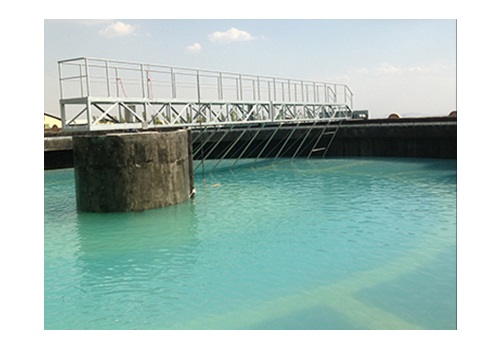 Product Introduction
Product Introduction

Clarifier
The Clarifier device needs special stirrers in addition to coagulant chemicals to coagulate organic substances and settle them on the bottom of the water so that the mixing and coagulation process takes place properly. In general, it can be said that the operation of the Clarifier includes the following:
The combination of water and special chemicals for coagulation of organic matter with high-speed stirrers
Coagulation of ingredients in water with a slow stirring speed
Shutting off the agitators and allowing the coagulated material to settle to the bottom of the pond or pool
Types of clarifiers
The wastewater treatment clarifier can be classified based on different features, the most important of which is the general shape of the device. So that in this category they can be divided into two general groups of circular and rectangular or square clarifiers. Each of these two groups has special features, which include:
Circular clarifier
As it is clear from the name of this group of clarifiers, the shape of the device is circular. According to the general structure considered in the circular clarifier design, a larger land with a minimum diameter of 3 meters is needed to install this equipment. One of the most important applications of the circular clarifier can be mentioned in large sewage treatment plants, in which a sludge remover can be easily installed to drain the clotted materials on the bottom of the pool easily. Sludge collection and discharge in the circular type of clarifiers is that it is placed by the sludge removal devices in the considered well at the lowest point of the device and finally discharged.
Rectangular clarifier
Another type of clarifiers that are used in small treatment plants is rectangular or square clarifiers. One of the most important features of this device is the lower cost of its construction if several clarifiers are needed in a treatment plant. The reason for this reduction in the cost of constructing a rectangular clarifier is the use of a common wall between two sources and the pond. The sludge collection system in this type of clarifier is such that the materials accumulated on the floor are transferred to the beginning of the pool and finally emptied.
Clarifier design
Based on other factors such as how the clarifier works, they can be divided into other groups, which include:
Single pass clarifier
One-pass clarifier refers to clarifiers that are produced horizontally and include a total of three room-like parts. The way this type of clarifier works is that in the first room, coagulant chemicals are mixed in water with a strong stirrer, and then they enter the next room. In the second room, at the same time, with a slower cycle, it provided the conditions for the sedimentation of clots and sludge in the water, and in the third room, the settled materials from the bottom of the draining pool and clear water are used.
Upstream flow clarifier
Unlike the single-pass clarifier, in the up flow clarifier, the process of flocculation of organic substances in water does not take place in separate environments. This type of wastewater treatment clarifier consists of a single-part device that first mixes chemicals in water with a rapid stirrer, then the speed of the stirrer is reduced and the coagulated materials have the opportunity to separate from the water and finally at the bottom of the pool or pond. Sewage treatment settles. The clear water produced from the overflow part of the device is used. This group of clarifiers are also divided into two general categories covered with sludge and collision with solids.
Making a clarifier
Clarifier design
In the design of the clarifier, several important factors must be considered in order to get the desired output from the device. One of the most important factors is the surface load, which is actually the amount of water passing through the surface per unit of time. The higher the speed or amount of water passing through the surface per unit of time, undoubtedly, the coagulated materials will have less opportunity to settle and ultimately lead to a decrease in the efficiency of the device.
Another very important thing that is considered in the design of the clarifier is the depth of the device. If a small depth is considered during the design of the clarifier, the coagulated material will re-enter the water and the quality and clarity of the water will be greatly reduced. Of course, if the depth of the device is considered higher than the standard, it will also have a negative effect on the efficiency of the device. Clarifiers that have a great depth will need more time to settle coagulated materials in the water, which can cause problems for large treatment plants.